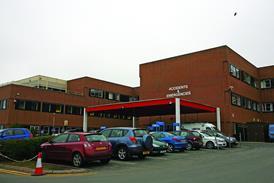The problem of patient safety persists, with about 1.2 million incidents reported every year. The NHS needs a less heroic, more systematic approach to ‘zero harm’ and patient safety
As many as one in every three dollars spent on healthcare in the US arises from failures in management, including errors and overtreatment, research shows. This extraordinary sum is unlikely to be very different in the NHS.
The estimate was made by one of the great champions of patient safety, Don Berwick, the former head of Medicare and Medicaid in the US and health adviser to the coalition government in the UK.
‘In healthcare we have taken a more heroic, less systematic approach and the problem of patient safety persists’
When set beside the thousands of NHS patients whom we know die or suffer serious injuries or infections each year as a result of medical errors, it highlights once again the urgent need to learn from our mistakes.
There have been gains: improved infection control in the NHS has led to a 90 per cent fall in cases of “superbug” MRSA. But the persistent failure to use and learn from mistakes is a huge missed opportunity.
About 1.2 million incidents are reported each year. At the Institute of Global Health Innovation at Imperial College London, which I lead, we are researching better ways of collecting and disseminating the data.
- Don’t let primary care patients slip through the nets
- CQC could become enforcer of ‘zero harm’ rules
- New patient safety incentives revealed
Sense of inevitability
For too long the mindset has been that patient harms are inevitable, that silos are natural and that heroism rather than thoughtful design keeps patients safe.
Other industries, notably airline and motor, have effectively managed errors and reduced harm. But in healthcare we have taken a local, more heroic, less systematic approach, and the problem of patient safety persists.
We have tended to focus on problems in isolation, one harm at a time, and our efforts have been simplistic and myopic.
If we are to save more lives and significantly reduce patient harm, we need to adopt a holistic, systematic approach that extends across cultural, technological and procedural boundaries – one that is based on the evidence of what works.
It is less glamorous and involves hard, unremitting effort. But a report led by Peter Pronovost, the internationally renowned expert on patient safety at Johns Hopkins Hospital, argues it is the only sure way to safer care.
The report will be presented at the World Innovation Summit on Health in Doha this month, which I will chair, at which Professor Berwick is a keynote speaker.
Safety code
In some cases, technology can help. One of the biggest causes of harm in hospitals is errors in prescribing and dispensing medicines.
A combination of computerised prescription forms, barcoding and automated dispensing machines that, unlike humans, are not prone to distraction, has been shown to improve safety.
There are also specific fixes that can help. In 2012, the European Medicines Agency warned of three fatal cases where patients had been given cancer drug Velcade, injected intrathecally (into the space around the spinal cord) rather than intravenously.
‘One of the biggest causes of harm in hospitals is errors in prescribing and dispensing medicines’
One way to prevent such errors, it said, was to use different connectors for medicines administered via the different routes.
But, as the summit’s report notes, although technology for improving safety has expanded, its usability and usefulness remain poor.
Electronic medical records have spread but they are still widely viewed as “clunky and clumsy” because it has proved difficult to get data out of them and tell who is at risk, which therapies were effective and what worked well.
The breakdown
Tackling one part of a system without considering its impact on other parts can lead to breakdown.
For example, infusion pumps delivering narcotics do not communicate with heart rate monitors.
‘Training in patient safety is still inadequate, leadership is underdeveloped and implementation of a “safe culture” is still superficial’
If a patient’s heart rate drops to a dangerous level because they are getting too much narcotic, the pump does not automatically reduce the amount of drug delivered – it relies on a nurse who must hear the heart monitor alarm against other beeping devices and make the adjustment.
The nurse thus saves a life and becomes the hero. But it would be better if all technologies communicated with each other.
In the system
Healthcare needs safer system designs. Training in patient safety is still inadequate, leadership is underdeveloped and implementation of a “safe culture” is still superficial.
Taking its lead from developments in highway and airline safety, the summit report argues for a holistic approach, integrated systems, comprehensive risk assessment and performance reporting, regulation and the creation of a “science for safety”.
Last summer Jeremy Hunt announced a patient safety drive in the NHS aimed at halving deaths from avoidable harm to save 6,000 lives over three years.
‘There’s a long way to go before we match the achievements of the airline and motor industries’
The measures the health secretary spelt out included a duty of candour on staff to be open with patients about mistakes, as well as the appointment of 5,000 “safety champions” charged with identifying unsafe care.
From April, all NHS trusts will be mandated to investigate deaths in their hospitals in a standardised way by specially trained consultants, who will be required to judge what proportion had a problem with their care and how much were avoidable.
These are welcome moves and indicate that we are starting to take safety in the NHS seriously. But there is a long way to go before we match the achievements of the airline and motor industries.
Lord Darzi is a surgeon, director of the Institute of Global Health Innovation at Imperial College London, and executive chair of the World Innovation Summit for Health. He was a Labour health minister from 2007-09


























5 Readers' comments